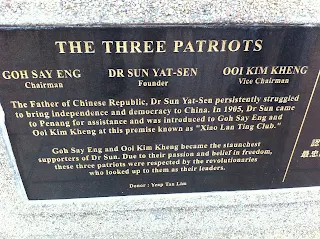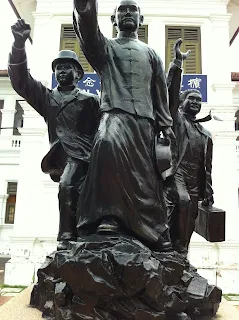
Dr Sun Yat Sen was the man ascribed to have founded a modern day republic for China in 1911, following a number of rebellions, massive fund raising efforts from private citizens and the sacrifice of various individuals. Dr Sun's connections with Penang is encapsulated in his visit to the Sio Lang Teng, a club for ethnic Chinese merchants, where he first met with his ultimately fervent supporters in Malaya for the Revolutionary cause - Goh Say Eng and Ooi Kim Kheng. Many a common folk led an oppressive life under the yoke of the Qing Dynasty - and the Qing Dynasty itself was faced with the challenges of internal rebellions, colonisation in various parts of coastal China by several Western powers and a reluctance to meet effectively with the opportunities of modernism.
Goh Say Eng was my maternal grand uncle, and he is depicted (above ) in front of the Sun Yat Sen Memorial in Georgetown, Penang, as one of three statues in united and coordinated effort to fight for the end of feudal rule in China. The Memorial is located in a building housing the Penang Philomatic Union, which is a reading club started by the political Chinese Revolutionay Alliance or Tung Meng Hooi. This Alliance began in Tokyo in 1905 to begin efforts to achieve the implementation of a Chinese republic, finally proclaimed on 11 October 1911. Goh Say Eng founded the Penang chapter of this Alliance under the rule of the colonial British administration.


On the Chinese mainland, examples of the injustice, debauchery and economic hardships under Qing Dynasty rule are illustrated in the Penang Memorial by a series of detailed and interesting miniature vistas. Above picture shows typical bullying by local militia in Chinese towns and below, opium smoking and playing with prostitutes were rife by officials of the Qing Dynasty in China.


The tin mines of Perak (depicted above) were a huge economic drawcard for immigrants from various southern Chinese provinces, from the middle of the 19th century, to come settle in what was then Malaya (today's peninsular Malaysia). The political and civil turmoil in China in the last hundred years of the Qing Dynasty also created incentives for mass-scale migration out of China to various parts of the world, including Australia, the USA, Thailand, Indonesia and the Philippines. Below, a quiet afternoon in the Penang base of the Sun Yat Sen Memorial Hall, which was officially opened in 2010.

Dr Sun had the privilege of being accommodated in various addresses in Georgetown, Penang whilst he was visiting to secure funding from and meeting up with overseas Chinese based in South-east Asia. Above picture depicts the various mansions and town houses that were involved, some of which still exist today. Penang offered such significant support, politically, financially and physically in the serious efforts to overthrow the last feudal dynasty in China that even the headquarters of Dr Sun's overseas coordinated efforts was moved from Singapore. Below is a depiction of the two headed snake, a term implied to Qing Dynasty officials who played a dangerous game of pleasing two opposing sides.

A representation of a regally seated Dr Sun (above) follows traditions in Chinese culture for respected and honoured national figures. This is reminiscent of the primary and national memorial in Nanjing in central China. Below is a representation of life in downtown Singapore in the early years of the 20th century, with a trishaw ride in downtown Chinatown.











2 comments:
Hello Kin Yue,
What a family relationship you've with the late Goh Say Eng.
A nice piece article to be read!
Then we are most likely related!
Post a Comment